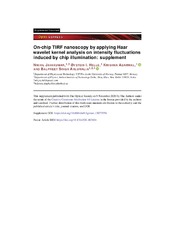Blar i forfatter Artikler, rapporter og annet (fysikk og teknologi) "Agarwal, Krishna"
-
On-chip TIRF nanoscopy by applying Haar wavelet kernel analysis on intensity fluctuations induced by chip illumination
Jayakumar, Nikhil; Helle, Øystein I.; Agarwal, Krishna; Ahluwalia, Balpreet Singh (Journal article; Tidsskriftartikkel; Peer reviewed, 2020-11-09)Photonic-chip based TIRF illumination has been used to demonstrate several on-chip optical nanoscopy methods. The sample is illuminated by the evanescent field generated by the electromagnetic wave modes guided inside the optical waveguide. In addition to the photokinetics of the fluorophores, the waveguide modes can be further exploited for introducing controlled intensity fluctuations for exploitation ... -
Photonic-chip: a multimodal imaging tool for histopathology
Villegas, Luis; Dubey, Vishesh Kumar; Tinguely, Jean-Claude; Coucheron, David Andre; Priyadarshi, Anish; Acuña Maldonado, Sebastian Andres; Agarwal, Krishna; Mateos, Jose M; Nystad, Mona; Hovd, Aud-Malin Karlsson; Fenton, Kristin Andreassen; Ahluwalia, Balpreet Singh (Conference object; Konferansebidrag, 2021-04)We propose the photonic-chip as a multimodal imaging platform for histopathological assessment, allowing large fields-of-view across diverse microscopy methods including total internal reflection fluorescence and single-molecule localization. -
Physics-based machine learning for subcellular segmentation in living cells
Sekh, Arif Ahmed; Opstad, Ida Sundvor; Godtliebsen, Gustav; Birgisdottir, Åsa Birna; Ahluwalia, Balpreet Singh; Agarwal, Krishna; Prasad, Dilip K. (Journal article; Tidsskriftartikkel; Peer reviewed, 2021-12-15)Segmenting subcellular structures in living cells from fluorescence microscope images is a ground truth (GT)-deficient problem. The microscopes’ three-dimensional blurring function, finite optical resolution due to light diffraction, finite pixel resolution and the complex morphological manifestations of the structures all contribute to GT-hardness. Unsupervised segmentation approaches are quite ... -
Scalable-resolution structured illumination microscopy
Butola, Ankit; Acuna Maldonado, Sebastian Andres; Hansen, Daniel Henry; Agarwal, Krishna (Journal article; Tidsskriftartikkel; Peer reviewed, 2022-11-15)Structured illumination microscopy suffers from the need of sophisticated instrumentation and precise calibration. This makes structured illumination microscopes costly and skill-dependent. We present a novel approach to realize super-resolution structured illumination microscopy using an alignment non-critical illumination system and a reconstruction algorithm that does not need illumination ... -
Silicon substrate significantly alters dipole-dipole resolution in coherent microscope
Liu, Zicheng; Agarwal, Krishna (Journal article; Tidsskriftartikkel; Peer reviewed, 2020-12-16)Considering a coherent microscopy setup, influences of the substrate below the sample in the imaging performances are studied, with a focus on high refractive index substrate such as silicon. Analytical expression of 3D full-wave vectorial point spread function, i.e. the dyadic Green's function is derived for the optical setup together with the substrate. Numerical analysis are performed in order ... -
Single-shot multispectral quantitative phase imaging of biological samples using deep learning
Bhatt, Sunil; Butola, Ankit; Kumar, Anand; Thapa, Pramila; Joshi, Akshay; Jadhav, Suyog S.; Singh, Neetu; Prasad, Dilip K.; Agarwal, Krishna; Mehta, Dalip Singh (Journal article; Tidsskriftartikkel; Peer reviewed, 2023-05-16)Multispectral quantitative phase imaging (MS-QPI) is a high-contrast label-free technique for morphological imaging of the specimens. The aim of the present study is to extract spectral dependent quantitative information in single-shot using a highly spatially sensitive digital holographic microscope assisted by a deep neural network. There are three different wavelengths used in our method: 𝜆=532 , ... -
Soft thresholding schemes for multiple signal classification algorithm
Acuña Maldonado, Sebastian Andres; Opstad, Ida Sundvor; Godtliebsen, Fred; Ahluwalia, Balpreet Singh; Agarwal, Krishna (Journal article; Tidsskriftartikkel; Peer reviewed, 2020-10-28)Multiple signal classification algorithm (MUSICAL) exploits temporal fluctuations in fluorescence intensity to perform super-resolution microscopy by computing the value of a super-resolving indicator function across a fine sample grid. A key step in the algorithm is the separation of the measurements into signal and noise subspaces, based on a single user-specified parameter called the threshold. ... -
Three-dimensional structured illumination microscopy data of mitochondria and lysosomes in cardiomyoblasts under normal and galactose-adapted conditions
Opstad, Ida Sundvor; Godtliebsen, Gustav; Ströhl, Florian; Myrmel, Truls; Ahluwalia, Balpreet Singh; Agarwal, Krishna; Birgisdottir, Åsa birna (Journal article; Tidsskriftartikkel; Peer reviewed, 2022-03-23)This three-dimensional structured illumination microscopy (3DSIM) dataset was generated to highlight the suitability of 3DSIM to investigate mitochondria-derived vesicles (MDVs) in H9c2 cardiomyoblasts in living or fxed cells. MDVs act as a mitochondria quality control mechanism. The cells were stably expressing the tandem-tag eGFP-mCherry-OMP25-TM (outer mitochondrial membrane) which can be used ... -
Viewing life without labels under optical microscopes
Ghosh, Biswajoy; Agarwal, Krishna (Journal article; Tidsskriftartikkel; Peer reviewed, 2023-05-25)Optical microscopes today have pushed the limits of speed, quality, and observable space in biological specimens revolutionizing how we view life today. Further, specific labeling of samples for imaging has provided insight into how life functions. This enabled label-based microscopy to percolate and integrate into mainstream life science research. However, the use of labelfree microscopy has been ... -
Viewing life without labels under optical microscopes
Ghosh, Biswajoy; Agarwal, Krishna (Journal article; Tidsskriftartikkel; Peer reviewed, 2023-05-25)Optical microscopes today have pushed the limits of speed, quality, and observable space in biological specimens revolutionizing how we view life today. Further, specific labeling of samples for imaging has provided insight into how life functions. This enabled label-based microscopy to percolate and integrate into mainstream life science research. However, the use of labelfree microscopy has been ...


 English
English norsk
norsk








